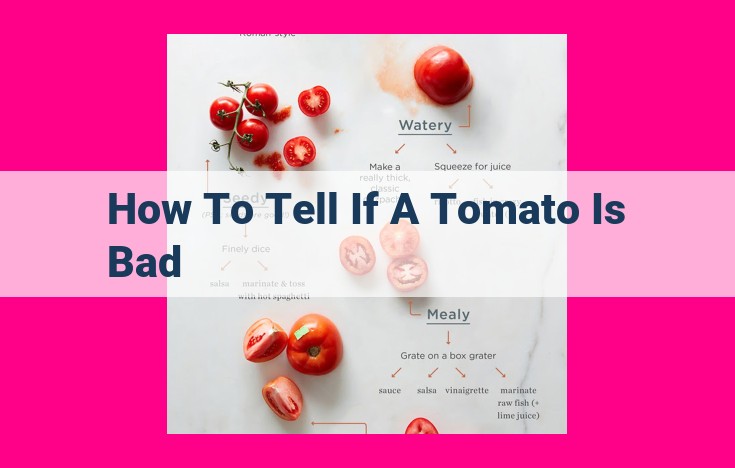Ultimate Guide To Detecting Tomato Spoilage: Appearance, Smell, And Texture

Detect tomato spoilage by examining its appearance. Mold growth indicates spoilage; soft spots suggest deterioration. Leaking juice or discoloration signal overripening. Off-odors, such as sour or fermented scents, reveal spoilage.
Visual Indicators of Produce Spoilage: Watch Out for These Red Flags
If you’re a produce lover like us, you know the pain of finding your once-crisp fruits and vegetables looking beyond their prime. To prevent any produce-related disappointments, let’s dive into the telltale signs of spoilage to keep your produce drawer fresh and fabulous.
Mold and Fungus: The Uninvited Guests
Mold and fungus are opportunistic travelers that love to hitch a ride on your produce. They thrive in moist environments, so if you spot any fuzzy or slimy growth, it’s time to bid farewell to that piece of produce.
Soft Spots: A Sign of Weakness
Indents and soft spots can be a major red flag for produce spoilage. These tender areas indicate damage to the fruit or vegetable, making it more susceptible to bacteria and mold growth. Avoid produce with soft spots, especially if you plan on storing it for a while.
Leaking Juice: A Sign of Overripening
When produce becomes overripe, it starts to break down and release its juices. This is often seen in fruits that are nearing the end of their shelf life, like peaches and bananas. While still edible, produce with leaking juice may have a softer texture and sweeter taste.
Discoloration: A Change for the Worse
Changes in color can indicate various stages of spoilage. For example, brown spots on apples may be a sign of bruising, while yellowing on bell peppers can indicate overripening. Keep an eye out for any discolorations that deviate from the normal appearance of the produce.
Olfactory Indicators of Produce Spoilage: A Guide to Smelling Your Food Freshness
When it comes to determining whether produce is safe to eat, our sense of smell is often overlooked. However, off-odors can be a telltale sign of spoilage that can help us avoid consuming spoiled food. Here’s a guide to using your nose to identify spoiled produce:
The Unmistakable Smell of Spoilage
Spoilage is often accompanied by a noticeable sour, fermented, or musty odor. This unpleasant smell is caused by the growth of bacteria and mold, which produce gases that give off their characteristic scents. Some fruits, like berries and citrus, may develop a vinegary smell when they start to go bad.
Specific Odors for Different Spoilage Types
- Moldy: A damp, musty smell indicates mold growth. Avoid produce with this odor, as mold can produce toxins that are harmful to consume.
- Fermented: A sour or alcoholic odor can be a sign of fermentation. This is common in fruits like bananas and apples, which produce ethanol as they ripen. While some fermented fruits are still safe to eat, it’s best to avoid those with an overly strong odor.
- Spoiled Meat: Produce that has gone bad may develop a putrid, rotten smell. This is an immediate red flag that the produce should be discarded.
The Importance of Smelling Produce
Smelling produce before consuming it is crucial to ensure its freshness and safety. By paying attention to off-odors, we can detect spoilage early on and avoid ingesting potentially harmful bacteria or toxins.
Tips for Detecting Off-Odors
- Sniff close to the produce: Hold the produce near your nose and take a deep inhale.
- Cut into the produce: For fruits and vegetables with thick skins, cut them open to reveal any unpleasant odors.
- Trust your instincts: If something smells off, it’s best to err on the side of caution and discard the produce.